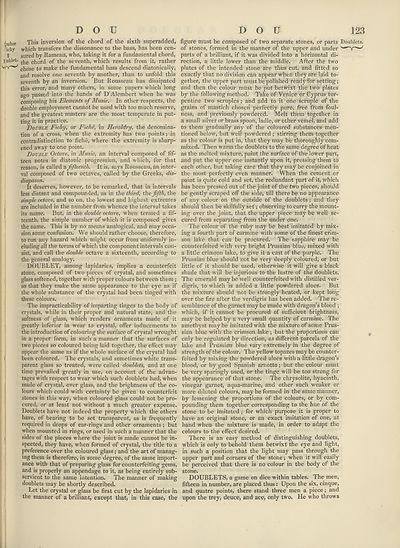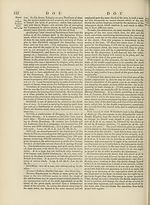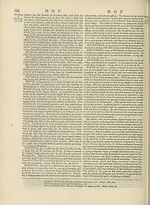Encyclopaedia Britannica > Volume 8, DIA-England
(133) Page 123
Download files
Complete book:
Individual page:
Thumbnail gallery: Grid view | List view

D O U
D O U
123
’lubie This inversion of the chord of the sixth superadded,
*khy which transfers the dissonance to the bass, has been cen-
II sured by Rameau, who, taking it for a fundamental chord,
jublet. jjjg chord 0f the seventh, which results from it, rather
chose to make the fundamental bass descend diatonically,
and resolve one seventh by another, than to unfold this
seventh by an inversion. But Rousseau has dissipated
this error, and many others, in some papers which long
ago passed into the hands of D’Alembert when he was
composing his Elements of Music. In other respects, the
double employment cannot be used with too much reserve,
and the greatest masters are the most temperate in put¬
ting it in practice.
Double Fichy, or Fiche, in Heraldry, the denomina¬
tion of a cross, when the extremity has two points; in
contradistinction to fiche, where the extremity is sharp¬
ened away to one point.
Double Octave, in Music, an interval composed of fif¬
teen notes in diatonic progression, and which, for that
reason, is called a fifteenth. It is, says Rousseau, an inter¬
val composed of two octaves, called by the Greeks, dis-
diapason.
It deserves, however, to be remarked, that in intervals
less distant and compounded, as in the third, the ffth, the
simple octave, and so on, the lowest and highest extremes
are included in the number from whence the interval takes
its name. But, in the double octave, when termed a fif¬
teenth, the simple number of which it is composed gives
the name. This is by no means analogical, and may occa¬
sion some confusion. We should rather choose, therefore,
to run any hazard which might occur from uniformly in¬
cluding all the terms of which the component intervals con¬
sist, and call the double octave a sixteenth, according to
the general analogy.
DOUBLET, among lapidaries, implies a counterfeit
stone, composed of two pieces of crystal, and sometimes
glass softened, together with proper colours between them ;
so that they make the same appearance to the eye as if
the whole substance of the crystal had been tinged with
these colours.
The impracticability of imparting tinges to the body of
crystals, while in their proper and natural state, and the
softness of glass, which renders ornaments made of it
greatly inferior in wear to crystal, offer inducements to
the introduction of colouring the surface of crystal wrought
in a proper form, in such a manner that the surfaces of
two pieces so coloured being laid together, the effect may
appear the same as if the whole surface of the crystal had
been coloured. The crystals, and sometimes white trans¬
parent glass so treated, were called doublets, and at one
time prevailed greatly in use, on account of the advan¬
tages with respect to wear which such doublets had, when
made of crystal, over glass, and the brightness of the co¬
lours which could with certainty be given to counterfeit
stones in this way, when coloured glass could not be pro¬
cured, or at least not without a much greater expense.
Doublets have not indeed the property which the others
have, of bearing to be set transparent, as is frequently
required in drops of ear-rings and other ornaments ; but
when mounted in rings, or used in such a manner that the
sides of the pieces where the joint is made cannot be in¬
spected, they have, w'hen formed of crystal, the title to a
preference over the coloured glass; and the art of manag¬
ing them is therefore, in some degree, of the same import¬
ance with that of preparing glass for counterfeiting gems,
and is properly an appendage to it, as being entirely sub¬
servient to the same intention. The manner of making
doublets may be shortly described.
Let the crystal or glass be first cut by the lapidaries in
the manner of a brilliant, except that, in this case, the
figure must be composed of two separate stones, or parts Doublets,
of stones, formed in the manner of the upper and under
parts of a brilliant, if it was divided into a horizontal di¬
rection, a little lower than the middle. After the twm
plates of the intended stone are thus cut, and fitted so
exactly that no division can appear when they are laid to¬
gether, the upper part must be polished ready for setting;
and then the colour must be put betwixt the two plates
by the following method. Take of Venice or Cyprus tur¬
pentine two scruples; and add to it one scruple of the
grains of mastich chosen perfectly pure, free from foul¬
ness, and previously powdered. Melt them together in
a small silver or brass spoon, ladle, or other vessel, and add
to them gradually any of the coloured substances men¬
tioned below, but well powdered ; stirring them together
as the colour is put in, that they may be thoroughly com¬
mixed. Then warm the doublets to the same degree of heat
as the melted mixture, paint the surface of the lower part,
and put the upper one instantly upon it, pressing them to
each other, but taking care that they may be conjoined in
the most perfectly even manner. When the cement or
paint is quite cold and set, the redundant part of it, which
has been pressed out of the joint of the two pieces, should
be gently scraped off the side, till there be no appearance
of any colour on the outside of the doublets ; and they
should then be skilfully set; observing to carry the mount¬
ing over the joint, that the upper piece may be well se¬
cured from separating from the under one.
The colour of the ruby may be best imitated by mix¬
ing a fourth part of carmine with some of the finest crim¬
son lake that can be procured. The sapphire may be
counterfeited with very bright Prussian blue, mixed with
a little crimson lake, to give it a cast of the purple. The
Prussian blue should not be very deeply coloured, or but
little of it should be used, otherwise it will give a black
shade that will be injurious to the lustre of the doublets.
The emerald may be well counterfeited wdth distilled ver¬
digris, to which is added a little powdered aloes. But
the mixture should not be strongly heated, or kept long
over the fire after the verdigris has been added. The re¬
semblance of the garnet may be made with dragon’s blood ;
which, if it cannot be procured of sufficient brightness,
may be helped by a very small quantity of carmine. The
amethyst may be imitated with the mixture of some Prus¬
sian blue with the crimson lake; but the proportions can
only be regulated by direction, as different parcels of the
lake and Prussian blue vary extremely in the degree of
strength of the colour. The yellow topazes may be counter¬
feited by mixing the powdered aloes with a little dragon’s
blood, or by good Spanish arnotto; but the colour must
be very sparingly used, or the tinge will be too strong for
the appearance of that stone. The chrysolite, hyacinth,
vinegar garnet, aqua-marine, and other such weaker or
more diluted colours, may be formed in the same manner,
by lessening the proportions of the colours, or by com¬
pounding them together corresponding to the hue of the
stone to be imitated; for which purpose it is proper to
have an original stone, or an exact imitation of one, at
hand when the mixture is made, in order to adapt the
colours to the effect desired.
There is an easy method of distinguishing doublets,
which is only to behold them betwixt the eye and light,
in such a position that the light may pass through the
upper part and corners of the stone; when it will easily
be perceived that there is no colour in the body of the
stone.
DOUBLETS, a game on dice within tables. The men,
fifteen in number, are placed thus; Upon the six, cinque,
and quatre points, there stand three men a piece; and
upon the trey, deuce, and ace, only two. He who throws
D O U
123
’lubie This inversion of the chord of the sixth superadded,
*khy which transfers the dissonance to the bass, has been cen-
II sured by Rameau, who, taking it for a fundamental chord,
jublet. jjjg chord 0f the seventh, which results from it, rather
chose to make the fundamental bass descend diatonically,
and resolve one seventh by another, than to unfold this
seventh by an inversion. But Rousseau has dissipated
this error, and many others, in some papers which long
ago passed into the hands of D’Alembert when he was
composing his Elements of Music. In other respects, the
double employment cannot be used with too much reserve,
and the greatest masters are the most temperate in put¬
ting it in practice.
Double Fichy, or Fiche, in Heraldry, the denomina¬
tion of a cross, when the extremity has two points; in
contradistinction to fiche, where the extremity is sharp¬
ened away to one point.
Double Octave, in Music, an interval composed of fif¬
teen notes in diatonic progression, and which, for that
reason, is called a fifteenth. It is, says Rousseau, an inter¬
val composed of two octaves, called by the Greeks, dis-
diapason.
It deserves, however, to be remarked, that in intervals
less distant and compounded, as in the third, the ffth, the
simple octave, and so on, the lowest and highest extremes
are included in the number from whence the interval takes
its name. But, in the double octave, when termed a fif¬
teenth, the simple number of which it is composed gives
the name. This is by no means analogical, and may occa¬
sion some confusion. We should rather choose, therefore,
to run any hazard which might occur from uniformly in¬
cluding all the terms of which the component intervals con¬
sist, and call the double octave a sixteenth, according to
the general analogy.
DOUBLET, among lapidaries, implies a counterfeit
stone, composed of two pieces of crystal, and sometimes
glass softened, together with proper colours between them ;
so that they make the same appearance to the eye as if
the whole substance of the crystal had been tinged with
these colours.
The impracticability of imparting tinges to the body of
crystals, while in their proper and natural state, and the
softness of glass, which renders ornaments made of it
greatly inferior in wear to crystal, offer inducements to
the introduction of colouring the surface of crystal wrought
in a proper form, in such a manner that the surfaces of
two pieces so coloured being laid together, the effect may
appear the same as if the whole surface of the crystal had
been coloured. The crystals, and sometimes white trans¬
parent glass so treated, were called doublets, and at one
time prevailed greatly in use, on account of the advan¬
tages with respect to wear which such doublets had, when
made of crystal, over glass, and the brightness of the co¬
lours which could with certainty be given to counterfeit
stones in this way, when coloured glass could not be pro¬
cured, or at least not without a much greater expense.
Doublets have not indeed the property which the others
have, of bearing to be set transparent, as is frequently
required in drops of ear-rings and other ornaments ; but
when mounted in rings, or used in such a manner that the
sides of the pieces where the joint is made cannot be in¬
spected, they have, w'hen formed of crystal, the title to a
preference over the coloured glass; and the art of manag¬
ing them is therefore, in some degree, of the same import¬
ance with that of preparing glass for counterfeiting gems,
and is properly an appendage to it, as being entirely sub¬
servient to the same intention. The manner of making
doublets may be shortly described.
Let the crystal or glass be first cut by the lapidaries in
the manner of a brilliant, except that, in this case, the
figure must be composed of two separate stones, or parts Doublets,
of stones, formed in the manner of the upper and under
parts of a brilliant, if it was divided into a horizontal di¬
rection, a little lower than the middle. After the twm
plates of the intended stone are thus cut, and fitted so
exactly that no division can appear when they are laid to¬
gether, the upper part must be polished ready for setting;
and then the colour must be put betwixt the two plates
by the following method. Take of Venice or Cyprus tur¬
pentine two scruples; and add to it one scruple of the
grains of mastich chosen perfectly pure, free from foul¬
ness, and previously powdered. Melt them together in
a small silver or brass spoon, ladle, or other vessel, and add
to them gradually any of the coloured substances men¬
tioned below, but well powdered ; stirring them together
as the colour is put in, that they may be thoroughly com¬
mixed. Then warm the doublets to the same degree of heat
as the melted mixture, paint the surface of the lower part,
and put the upper one instantly upon it, pressing them to
each other, but taking care that they may be conjoined in
the most perfectly even manner. When the cement or
paint is quite cold and set, the redundant part of it, which
has been pressed out of the joint of the two pieces, should
be gently scraped off the side, till there be no appearance
of any colour on the outside of the doublets ; and they
should then be skilfully set; observing to carry the mount¬
ing over the joint, that the upper piece may be well se¬
cured from separating from the under one.
The colour of the ruby may be best imitated by mix¬
ing a fourth part of carmine with some of the finest crim¬
son lake that can be procured. The sapphire may be
counterfeited with very bright Prussian blue, mixed with
a little crimson lake, to give it a cast of the purple. The
Prussian blue should not be very deeply coloured, or but
little of it should be used, otherwise it will give a black
shade that will be injurious to the lustre of the doublets.
The emerald may be well counterfeited wdth distilled ver¬
digris, to which is added a little powdered aloes. But
the mixture should not be strongly heated, or kept long
over the fire after the verdigris has been added. The re¬
semblance of the garnet may be made with dragon’s blood ;
which, if it cannot be procured of sufficient brightness,
may be helped by a very small quantity of carmine. The
amethyst may be imitated with the mixture of some Prus¬
sian blue with the crimson lake; but the proportions can
only be regulated by direction, as different parcels of the
lake and Prussian blue vary extremely in the degree of
strength of the colour. The yellow topazes may be counter¬
feited by mixing the powdered aloes with a little dragon’s
blood, or by good Spanish arnotto; but the colour must
be very sparingly used, or the tinge will be too strong for
the appearance of that stone. The chrysolite, hyacinth,
vinegar garnet, aqua-marine, and other such weaker or
more diluted colours, may be formed in the same manner,
by lessening the proportions of the colours, or by com¬
pounding them together corresponding to the hue of the
stone to be imitated; for which purpose it is proper to
have an original stone, or an exact imitation of one, at
hand when the mixture is made, in order to adapt the
colours to the effect desired.
There is an easy method of distinguishing doublets,
which is only to behold them betwixt the eye and light,
in such a position that the light may pass through the
upper part and corners of the stone; when it will easily
be perceived that there is no colour in the body of the
stone.
DOUBLETS, a game on dice within tables. The men,
fifteen in number, are placed thus; Upon the six, cinque,
and quatre points, there stand three men a piece; and
upon the trey, deuce, and ace, only two. He who throws
Set display mode to:
![]() Universal Viewer |
Universal Viewer | ![]() Mirador |
Large image | Transcription
Mirador |
Large image | Transcription
Images and transcriptions on this page, including medium image downloads, may be used under the Creative Commons Attribution 4.0 International Licence unless otherwise stated. ![]()
| Encyclopaedia Britannica > Encyclopaedia Britannica > Volume 8, DIA-England > (133) Page 123 |
|---|
| Permanent URL | https://digital.nls.uk/193324734 |
|---|
| Attribution and copyright: |
|
|---|
| Description | Ten editions of 'Encyclopaedia Britannica', issued from 1768-1903, in 231 volumes. Originally issued in 100 weekly parts (3 volumes) between 1768 and 1771 by publishers: Colin Macfarquhar and Andrew Bell (Edinburgh); editor: William Smellie: engraver: Andrew Bell. Expanded editions in the 19th century featured more volumes and contributions from leading experts in their fields. Managed and published in Edinburgh up to the 9th edition (25 volumes, from 1875-1889); the 10th edition (1902-1903) re-issued the 9th edition, with 11 supplementary volumes. |
|---|---|
| Additional NLS resources: |
|

